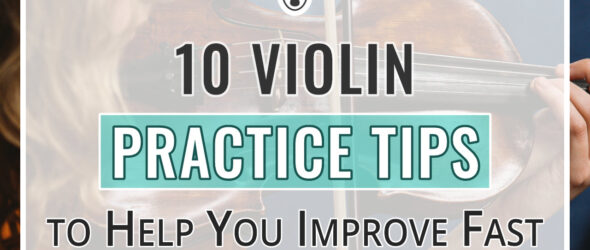Check out my best violin tips which will help you see fast improvements in your playing.
In our fast-paced world, it can be hard to have the patience to learn something new. As a beginner violin player, I know you want to learn to play fast! Luckily for you, I have many practice tips up my sleeve to help you learn the violin at a quick pace. Today we’ll go over lifestyle, mindset, and violin practice tips to help you see fast improvement.
However, I do want to include a quick disclaimer:
Learning the violin is a journey. It’s not a race, and music doesn’t always need to be perfect. Music brings us together and helps us express our feelings. When we’re always worrying about playing with perfect technique and proper posture, the music itself can suffer. I know you’re reading this article because you want to improve quickly, but learning to play the violin is a process that can take many years. Play music you love, and go in with a good attitude, and your violin journey will be so rewarding!
1. Find just a little time to practice each day
Practice often to see quicker results. The more days you practice, the more your brain will retain what you’re learning. Also, the more often you play, the more it’ll become part of your daily routine!
Most professionals, and even some beginners who improve quickly, dedicate most of their day to practicing the violin. I know it may not be possible to dedicate your life to practicing—I can’t do that, either! But, if you can set aside 5 minutes or a bit more each day, you’ll be better off than just waiting for that one day here or there where you can fit in a longer practice session.
Practice consistently, and you’ll start to see faster changes!
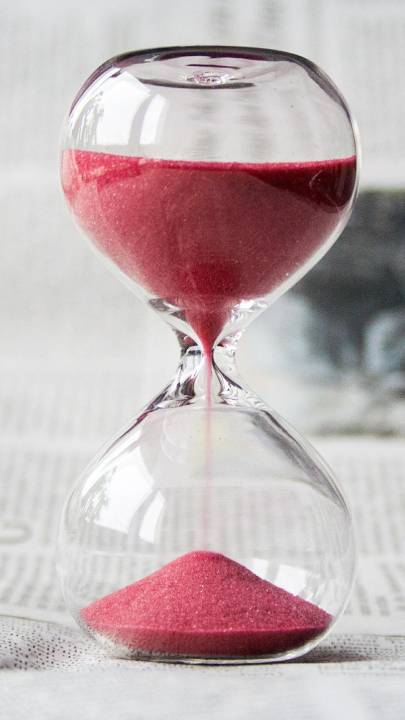
2. Give yourself goals for each practice session
Give yourself small goals and even a “schedule” each day that you practice. Working on specific techniques and ideas will help you advance faster than just playing your music over and over.
Mindless repetition takes up time in your practice session, but it’s not very efficient. You’ll learn more, faster if you know exactly what you need to work on and focus mostly on just improving that.
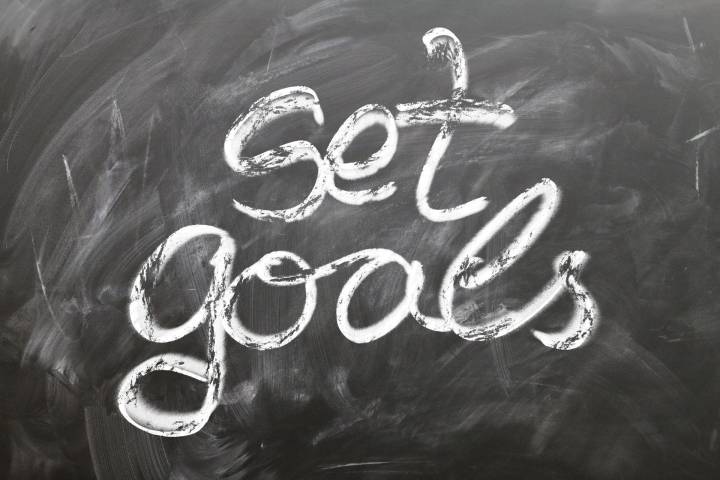
3. Find a practice routine that works for you
I’m often asked, “what’s a good practice routine?” My answer is: anything that is sustainable for you.
Consistent practice is one of the best ways to make steady progress on any instrument, including the violin.
Create a routine or schedule what you can follow most times you practice. Maybe you warm up for five minutes, practice an etude for ten minutes, one piece for fifteen minutes, and then review for five minutes. Finding structure and routine within your practice time will help you stay on track and make progress.
Download the blank fillable practice plan below, write down your routine, and each day tick as done the exercises that you practiced.
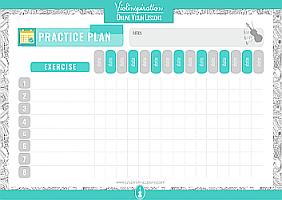
Fillable Practice Plan [PDF]
For practice routine suggestions and more violin practice tips, take a look at How to Practice the Violin to Bring Out the Best in You.
4. Use Good Practice Techniques
One way to make quick progress on the violin is to use good practice strategies. Here are a few practice tips that help musicians learn music faster than others.
Practice your music with a metronome
Rhythm is one of the core components of music. It’s very important to play with a steady pulse, especially if you plan to play with others. A metronome keeps the beat for you, while you practice playing over it. This tool will both help you play with a steady beat, and understand complex rhythms.
Even if you’re not struggling with rhythm in a given piece of music, try playing with a metronome. You might notice new aspects of your playing that need some improvement!
Mark Beats in Your Sheet Music
I like to draw vertical lines in my music where the beats fall in each measure. I usually only do this when I struggle with the rhythm in a passage, but as a beginner, doing this often could be very beneficial as you learn more and more difficult rhythms, like dotted notes and syncopation.

Pairing this up with a metronome will give you such a strong sense of rhythm! Give it a try the next time you practice.
Repeat the Correct Version Many More Times than You Did the Wrong Version
A good rule of thumb is to play a passage correctly many more times than you’ve played it incorrectly.
If you play something wrong many times, your brain will remember to play it like that every time. Be sure that you repeat a passage correctly more times than you play it incorrectly, so your brain remembers the correct way the next time you come back to it.
It’s easier and more effective to build good technique the first time around than it is to break bad habits. That’s why we want to learn how to play music correctly the first time around!
Listen to the sounds you’re making
It’s important to analyze what you’re hearing as you play. Of course, some of us are overly critical and perfectionism gets in the way. However, analyzing your playing will allow you to pinpoint exactly what is and isn’t going the way you want it to.
It can be difficult to analyze your work without being overly critical and mean, but if you can step back and analyze with neutral statements, that can make the process easier. Thinking “this measure is out of tune” is much more productive than thinking “this measure sounds awful.” Realizing what exactly is going on will help you understand exactly what to focus on improving in your practice sessions.
Practice slowly
Practicing slowly is one of the quickest ways to learn!
Give yourself time to think through everything that’s going on. In music, there are almost always so many things to focus on! In just one passage we might need to think about left-hand technique, intonation, bow control, and string crossings. That’s a lot to master all at once!
When you practice, only go as fast as you can play everything correctly. That might be very slow at the start, but that’s okay! Learning the music correctly the first time around will save you time in the long run, since you won’t need to re-learn anything.
Check That Your Posture and Bow Hold Are Correct
Solidifying your left hand and right hand holds, and overall posture early on will give you a strong foundation to build on top of, and make everything easier when you learn advanced techniques down the road!
As you practice, it can be very helpful to play in front of a mirror to check your posture. If you don’t have a mirror, try recording yourself and watching it back! Look at your left hand: are you playing on your fingertips? Is your wrist relaxed and in line with your arm? How about your bow arm, are you playing with a straight bow across the strings? Is your bow hold correct? These are all techniques that can be very tricky to master at the start, and where I see most beginner violin players struggle.
Read my blog post, 5 Steps to Proper Violin Posture, to learn the correct posture, and if you need them, look for wearable aids you can buy to help your posture feel more natural when you start playing.
5. Find a teacher or method to follow
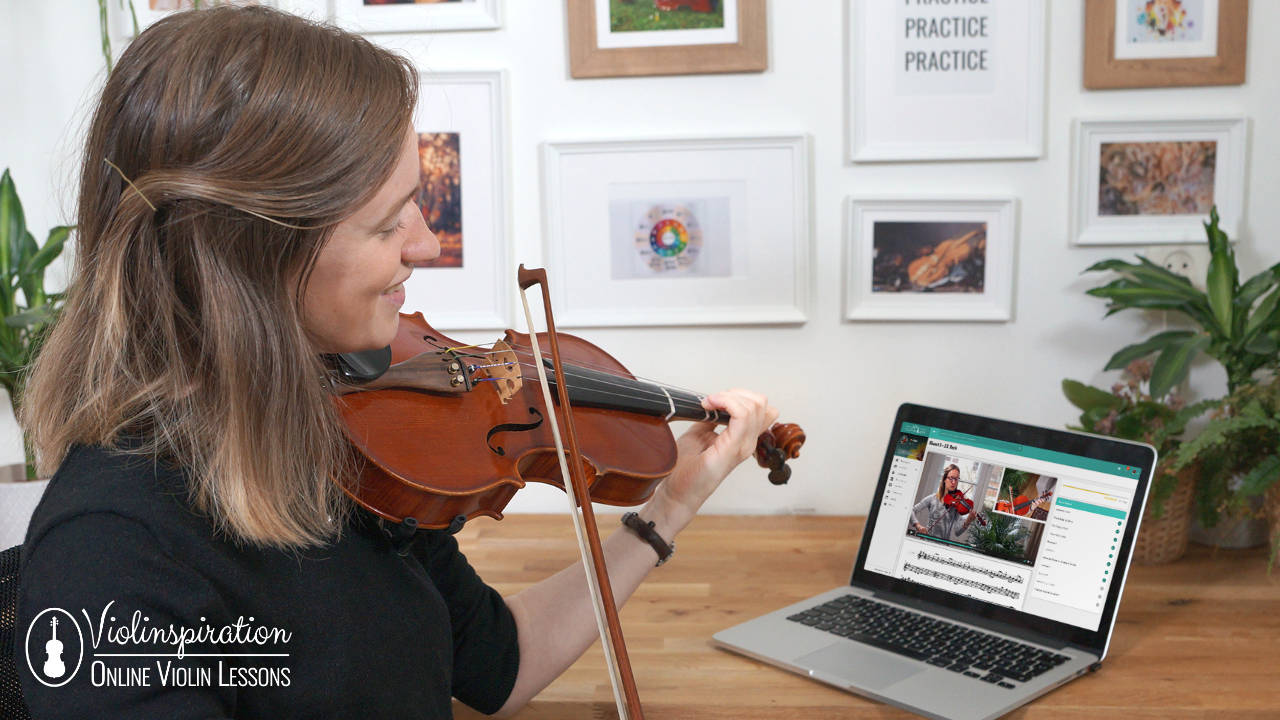
A good teacher not only shows you how to hold the violin and use correct bowing techniques, but they’ll cheer you on and show you what music is all about. Weekly (or at least regular) violin lessons help you to stay in a routine where you play often. It’s great to have the weekly goal of getting a piece or an exercise ready and receiving personalized feedback.
If working with a violin teacher isn’t on the table for you, it’s helpful to find a method that you can follow yourself, like the Suzuki Method, or another series of books like the ABCs of Violin for the Absolute Beginner or Essential Elements. Yet another way would be to learn in an online school like Julia’s Violin Academy. In my Academy, I provide you with structured courses, you can get feedback on your playing from a professional violin teacher, and join a community of like-minded students.
If you prefer to learn from free resources, make sure to stay a bit on my website exploring it, and be sure to check my Complete Beginner’s Guide to see the range of my free lessons!
Using a method or working with a violin teacher will help you improve faster than just watching random YouTube videos because you’ll be following a structure that’s proven to help beginners learn to play the violin and progress to higher levels.
6. Listen to as much violin music as you can
When you don’t have much time to play violin, listen to violin music! This is an easy way to continue making progress when you’re busy. You can even multitask while listening! When you’re cleaning, put on some music. Reading? Put on some quiet music in the background.

Everything you hear, and every video you watch, will help you learn what sound you want to get out of the violin. By watching the professionals play, you can see correct posture, beautiful bowing technique, and even hear small nuances.
If you have the time, write down your observations! Is there anything you can incorporate into your own playing? If any questions came up, bring them to your teacher, or look them up online. In addition to just enjoying beautiful music, you can learn so much about technique and sound by listening to or watching a performance.
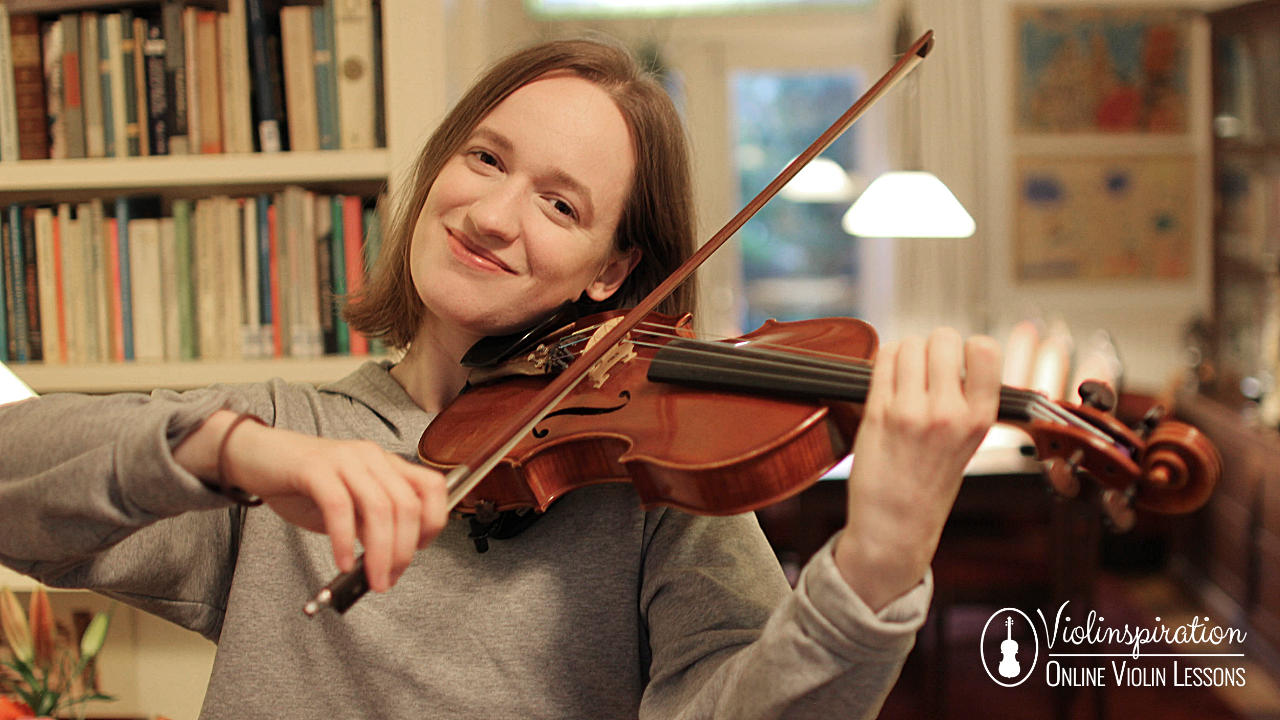
7. Learn the music that is fun!
Learn the music that you enjoy, no matter the genre. Pop songs, classical music, folk songs, and anything in between can sound great on the violin. Everything that you play will help you learn the violin faster, and you might as well have fun in the meantime!
Try mixing a favorite song into your practice session, along with your other exercises and study pieces. If you’re unsure of where to find the music you enjoy, try searching here on my website! I offer sheet music (with easy violin tabs) for hundreds of different songs from all genres!
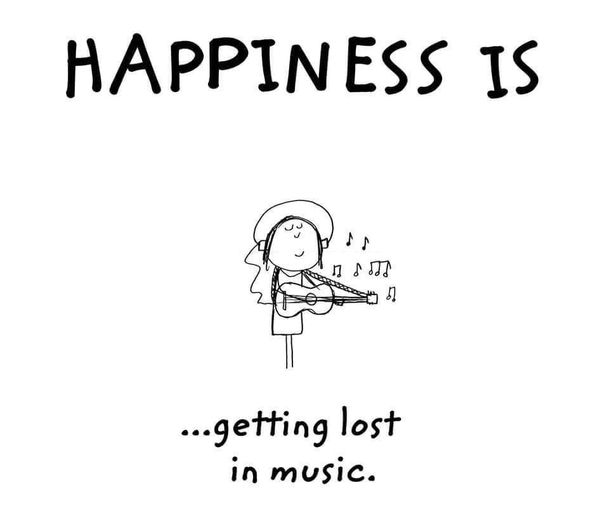
Keep the joy of playing violin and making music at the forefront of your mind, and you’ll be more focused and dedicated to learning violin in general.
8. Learn about music theory

Music theory is the study of learning how music is written and how it works. In addition to reading music, it’s so helpful to learn about the structure of music, key signatures, and rhythms while you learn to play the violin.
Knowing the reason why we have different time signatures, and memorizing key signatures will give you a deeper understanding of music, and in turn, will help your violin playing feel easier.
If you haven’t learned how to read sheet music yet, check out this article. For something a little more advanced, I recommend my guide to reading key signatures. Learning about music theory may sound daunting, but I promise it’ll help you understand the violin better!
9. Review old music often
When we’re learning violin and we want to make fast progress, we tend to rush through working a song, and put it away before it’s really “finished.” Try playing through old pieces, or continue reviewing a song even after you start learning something new.
Coming back to an older piece can be so rewarding! You might find passages that were difficult before are suddenly much more simple, now that you have better technique and more experience under your belt.
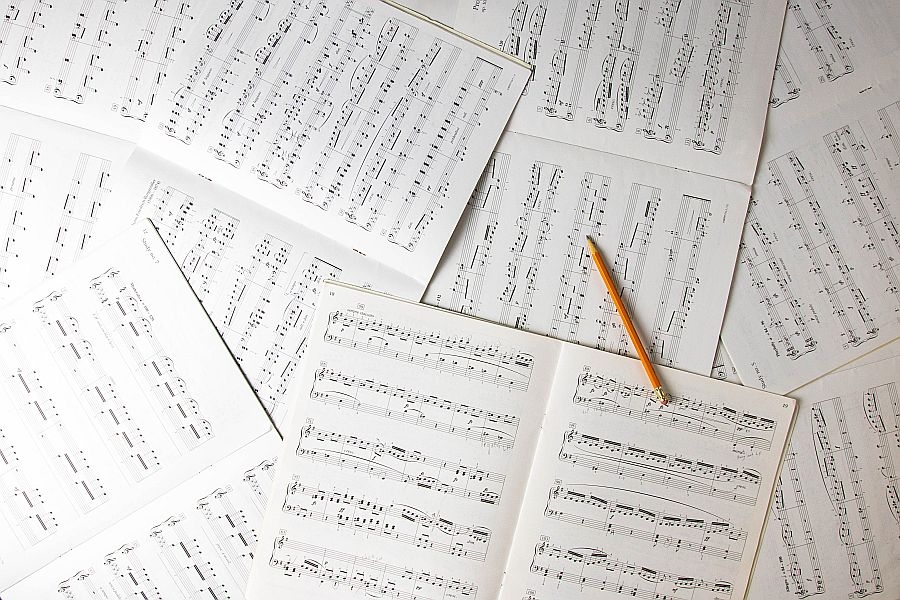
By continuing to review and practice older pieces, you’ll be able to play them at a much higher level than if you’d just put them away. Hearing yourself play with a beautiful sound, even on a song that’s “easy” is so rewarding, and will show you how much progress you’ve made. Really perfecting and polishing up a piece of music can be so rewarding, and then if you want to perform, you’ll have something ready!
10. Play with Good Fingerings and Bowings
If you have a teacher, use the fingering and bowing suggestions that they give you. If you’re working out of a method book or using sheet music from my site, stick to what’s written in the score. These suggestions are written either because they’re the best, or because they’ll teach you a specific skill.
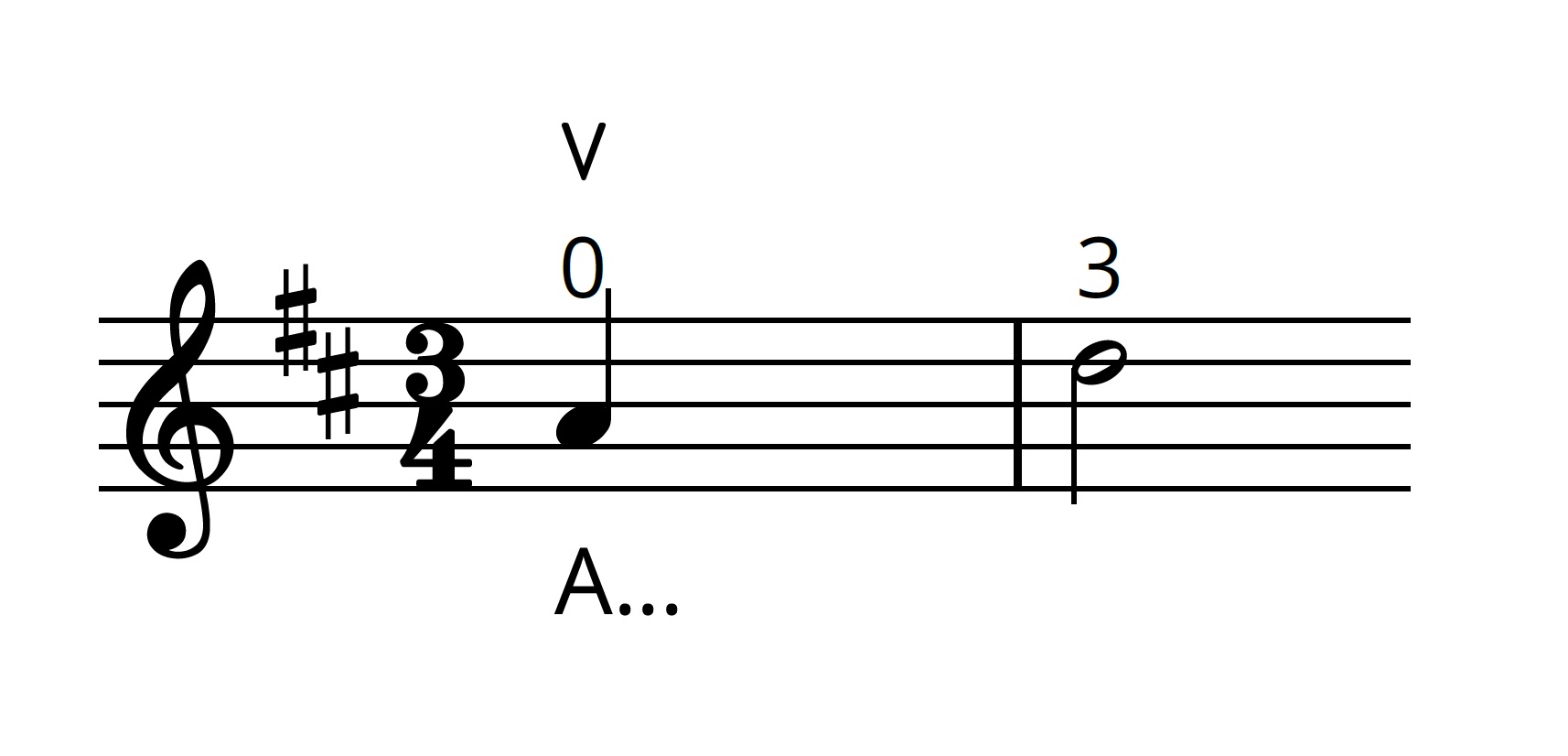
After some time of playing suggested fingerings and bowings, they’ll start to become a habit, and you’ll have a better instinct of what will work the best for a given passage that has no suggestions written in. But while you’re still a beginner, stick to what’s written in to learn best practices.
Finally… Enjoy the journey
Learning a new instrument is always a long process. It takes time to retain everything that you practice, and you may feel discouraged when you can’t play your favorite song, or when you make scratchy sounds.
Take your musical journey one step at a time, and know that no one learns violin overnight. Enjoy the process, and have fun just trying! So many of us are afraid of failing, but you can never fail when you make music, as long as you’re enjoying yourself.
It can be beneficial to find a community of like-minded beginners to keep you excited. Stick around a while on my site, and you’ll find motivational posts and comment sections full of others who are going through the same journey as you. Also, I'd like to take this opportunity to invite you to the community of my students at Julia's Violin Academy, where you're never alone, where you can openly share your progress, and where you can find some extra inspiration and motivation.
Violin progress isn’t just measured in skill level or pieces learned—it’s about how much joy you find along the way. Keep your violin journey enjoyable by celebrating small wins, connecting with others, and staying curious about music.
If you’re looking for a fun-filled experience to enhance your journey, Violin Villa might be the perfect opportunity. At this special retreat, you’ll play music with others in an orchestra, explore your creativity through jam sessions and improvisation, and enjoy playful activities like violin charades. Most importantly, it’s a chance to relax, have fun, and connect with fellow adult beginners who share your passion for the violin.
Learning violin quickly is not the most important thing you should focus on in your violin journey, but I hope my tips today leave you feeling motivated and focused to practice the violin and improve your violin skills! If you’d like to hear more of my thoughts on this topic, watch this video.
